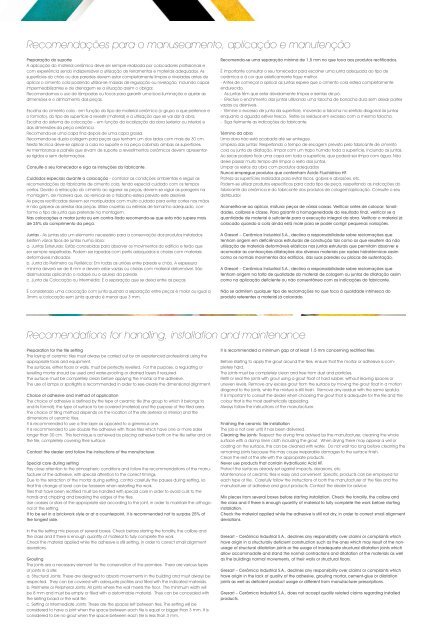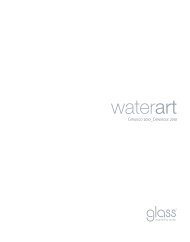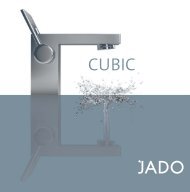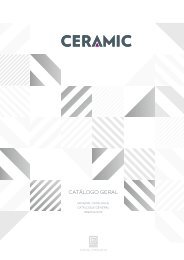You also want an ePaper? Increase the reach of your titles
YUMPU automatically turns print PDFs into web optimized ePapers that Google loves.
Recomendações para o manuseamento, aplicação e manutenção<br />
Preparação do suporte<br />
A aplicação do material cerâmico deve ser sempre realizada por colocadores profissionais e<br />
com experiência sendo indispensável a utilização de ferramentas e materiais adequados. As<br />
superfícies do chão ou das paredes devem estar completamente limpas e niveladas antes de<br />
aplicar o cimento cola podendo utilizar-se massas de regulação ou nivelação, incluindo capas<br />
impermeabilizantes e de drenagem se a situação assim o obrigar.<br />
Recomendamos o uso de lâmpadas ou focos para garantir uma boa iluminação e ajustar as<br />
dimensões e o alinhamento das peças.<br />
Escolha do cimento cola - em função do tipo de material cerâmico (o grupo a que pertence e<br />
o formato), do tipo de superfície a revestir (material) e a utilização que se vai dar à obra.<br />
Escolha do sistema de colocação – em função da localização da obra (exterior ou interior) e<br />
das dimensões da peça cerâmica.<br />
Recomenda-se uma capa fina depois de uma capa grossa.<br />
Recomenda-se dupla colagem para peças que tenham um dos lados com mais de 30 cm.<br />
Nesta técnica deve-se aplicar a cola no suporte e na peça cobrindo ambas as superfícies.<br />
As membranas e painéis que sirvam de suporte a revestimentos cerâmicos devem apresentarse<br />
rígidos e sem deformações.<br />
Consulte o seu fornecedor e siga as instruções do fabricante.<br />
Cuidados especiais durante a colocação - controlar as condições ambientais e seguir as<br />
recomendações do fabricante de cimento cola, tendo especial cuidado com os tempos<br />
certos. Devido à retracção do cimento ao agarrar as peças, devem-se vigiar as paragens na<br />
montagem, de maneira que, ao reiniciar-se o trabalho esteja previsto este desnível.<br />
As peças rectificadas devem ser manipuladas com muito cuidado para evitar cortes nas mãos<br />
e não golpear as arestas das peças. Utilize cruzetas ou estrelas de tamanho adequado, conforme<br />
o tipo de junta que pretende na montagem.<br />
Nas colocações a matar junta ou em contra-fiado recomenda-se que esta não supere mais<br />
de 25% do comprimento da peça.<br />
Juntas - As juntas são um elemento necessário para a conservação dos produtos instalados.<br />
Existem vários tipos de juntas numa obra:<br />
a. Juntas Estruturais: Estão concebidas para absorver os movimentos do edifício e terão que<br />
ser sempre respeitadas. Podem ser tapadas com perfis adequados e cheias com materiais<br />
deformáveis indicados.<br />
b. Junta do Perímetro ou Periférica: Em todas as uniões entre parede e chão. A espessura<br />
mínima deverá ser de 8 mm e devem estar vazias ou cheias com material deformável. São<br />
dissimuladas aplicando o rodapé ou o azulejo da parede.<br />
c. Junta de Colocação ou Intermédia: É a separação que se deixa entre as peças.<br />
É considerado uma colocação com junta quando a separação entre peças é maior ou igual a<br />
3mm; e colocação sem junta quando é menor que 3 mm.<br />
Preparation for the tile setting<br />
The laying of ceramic tiles must always be carried out by an experienced professional using the<br />
appropriate tools and equipment.<br />
The surfaces, either floors or walls, must be perfectly levelled. For this purpose, a regulating or<br />
levelling mortar should be used and water-proofing or drained layers if required.<br />
The surface must be completely clean before applying the mortar or the adhesive.<br />
The use of lamps or spotlights is recommended in order to see clearly the dimensional alignment.<br />
Choice of adhesive and method of application<br />
The choice of adhesive is defined by the type of ceramic tile (the group to which it belongs to<br />
and its format), the type of surface to be covered (material) and the purpose of the tiled area.<br />
The choice of tiling method depends on the location of the site (exterior or interior) and the<br />
dimensions of ceramic tiles.<br />
It is recommended to use a fine layer as opposed to a generous one.<br />
It is recommended to use double the adhesive with those tiles which have one or more sides<br />
longer than 30 cm. This technique is achieved by placing adhesive both on the tile setter and on<br />
the tile, completely covering their surface.<br />
Contact the dealer and follow the instructions of the manufacturer.<br />
Special care during setting<br />
Pay close attention to the atmospheric conditions and follow the recommendations of the manufacturer<br />
of the adhesive, with special attention to the correct timings.<br />
Due to the retraction of the mortar during setting, control carefully the pauses during setting, so<br />
that this change of level can be foreseen when restarting the work.<br />
Tiles that have been rectified must be handled with special care in order to avoid cuts to the<br />
hands and chipping and breaking the edges of the tiles.<br />
Use crosses or stars of the appropriate size according to the joint, in order to maintain the orthogonal<br />
of the setting.<br />
If to be set in a brickwork style or at a counterpoint, it is recommended not to surpass 25% of<br />
the longest side.<br />
In the tile setting mix pieces of several boxes. Check before starting the tonality, the calibre and<br />
the class and if there is enough quantity of material to fully complete the work<br />
Check the material applied while the adhesive is still setting, in order to correct small alignment<br />
deviations.<br />
Grouting<br />
The joints are a necessary element for the conservation of the premises. There are various types<br />
of joints in a site:<br />
a. Structural Joints: These are designed to absorb movements in the building and must always be<br />
respected. They can be covered with adequate profiles and filled with the indicated materials.<br />
b. Perimeter or Peripheral Joints: All joints where the wall meets the floor. The minimum width will<br />
be 8 mm and must be empty or filled with a deformable material. They can be concealed with<br />
the skirting board or the wall tile.<br />
c. Setting or Intermediate Joints: These are the spaces left between tiles. The setting will be<br />
considered to have a joint when the space between each tile is equal or bigger than 3 mm. It is<br />
considered to be no grout when the space between each tile is less than 3 mm.<br />
Recomenda-se uma separação mínima de 1,5 mm no que toca aos produtos rectificados.<br />
É importante consultar o seu fornecedor para escolher uma junta adequada ao tipo de<br />
cerâmica e à cor que esteticamente fique melhor.<br />
- Antes de começar a aplicar as juntas espere que o cimento cola esteja completamente<br />
endurecido.<br />
- As juntas têm que estar devidamente limpas e isentas de pó.<br />
- Efectue o enchimento das juntas utilizando uma talocha de borracha dura sem deixar partes<br />
vazias ou desníveis.<br />
- Elimine o excesso de junta da superfície, movendo a talocha no sentido diagonal às juntas<br />
enquanto a aguada estiver fresca. Retire os resíduos em excesso com a mesma talocha.<br />
- Siga fielmente as indicações do fabricante.<br />
Término da obra<br />
Uma obra não está acabada até ser entregue.<br />
Limpeza das juntas: Respeitando o tempo de secagem previsto pelo fabricante de cimento<br />
cola ou junta de dilatação, limpar com um trapo húmido toda a superfície, incluindo as juntas.<br />
Ao secar poderá ficar uma capa em toda a superfície, que poderá ser limpa com água. Não<br />
deixe passar muito tempo até limpar o resto das juntas.<br />
Limpar os restos da obra com produtos adequados<br />
Nunca empregue produtos que contenham Ácido Fluohídrico HF.<br />
Proteja as superfícies realizadas para evitar riscos, golpes e abrasões, etc.<br />
Podem-se utilizar produtos específicos para cada tipo de peça, respeitando as indicações do<br />
fabricante da cerâmica e do fabricante dos produtos de colagem/aplicação. Consulte o seu<br />
distribuidor.<br />
Aconselha-se ao aplicar, misturar peças de várias caixas. Verificar antes de colocar: tonalidades,<br />
calibres e classe. Para garantir a homogeneidade do resultado final, verificar se a<br />
quantidade de material é suficiente para a execução integral da obra. Verificar o material já<br />
colocado quando a cola ainda está mole para se poder corrigir pequenas variações.<br />
A Gresart – Cerâmica Industrial S.A., declina a responsabilidade sobre reclamações que<br />
tenham origem em deficiências estruturais de construção tais como as que resultem da não<br />
utilização de materiais deformáveis elásticos nas juntas estruturais que permitam absorver e<br />
acomodar as contracções-dilatações dos diversos materiais por razões hidrotérmicas assim<br />
como os normais movimentos dos edifícios, das suas paredes ou placas de sustentação.<br />
A Gresart – Cerâmica Industrial S.A., declina a responsabilidade sobre reclamações que<br />
tenham origem na falta de qualidade do material de colagem ou juntas de dilatação assim<br />
como na aplicação deficiente ou não consentânea com as indicações do fabricante.<br />
Não se admitem qualquer tipo de reclamações no que toca à qualidade intrínseca do<br />
produto referentes a material já colocado.<br />
Recomendations for handling, installation and maintenance<br />
It is recommended a minimum gap of at least 1.5 mm concerning rectified tiles.<br />
Before starting to apply the grout around the tiles, ensure that the mortar or adhesive is completely<br />
hard.<br />
The joints must be completely clean and free from dust and particles.<br />
Refill or seal the joints with grout using a grout float of hard rubber, without leaving spaces or<br />
uneven levels. Remove any excess grout from the surface by moving the grout float in a motion<br />
diagonal to the joints, while the mixture is still fresh. Remove any residue with the same spatula.<br />
It is important to consult the dealer when choosing the grout that is adequate for the tile and the<br />
colour that is the most aesthetically appealing.<br />
Always follow the instructions of the manufacturer.<br />
Finishing the ceramic tile installation<br />
The job is not over until it has been delivered.<br />
Cleaning the joints: Respect the drying time advised by the manufacturer, cleaning the whole<br />
surface with a damp linen cloth including the grout. When drying there may appear a veil or<br />
coating on the surface, this can be cleaned with water. Do not wait too long before cleaning the<br />
remaining joints because this may cause irreparable damages to the surface finish.<br />
Clean the rest of the site with the appropriate products.<br />
Never use products that contain Hydrofluoric Acid HF.<br />
Protect the surfaces already set against impacts, abrasions, etc.<br />
Maintenance of ceramic tiles is easy and convenient. Specific products can be employed for<br />
each type of tile. Carefully follow the instructions of both the manufacturer of the tiles and the<br />
manufacturer of adhesive and grout products. Contact the dealer for advice.<br />
Mix pieces from several boxes before starting installation. Check the tonality, the calibre and<br />
the class and if there is enough quantity of material to fully complete the work before starting<br />
installation.<br />
Check the material applied while the adhesive is still not dry, in order to correct small alignment<br />
deviations.<br />
Gresart – Cerâmica Industrial S.A., declines any responsibility over claims or complaints which<br />
have origin in a structurally deficient construction such as the ones which may result of the nonusage<br />
of structural dilatation joints or the usage of inadequate structural dilatation joints which<br />
allow accommodate and stand the normal contractions and dilatation of the materials as well<br />
as the buildings normal movements, of their walls or structural floors.<br />
Gresart – Cerâmica Industrial S.A., declines any responsibility over claims or complaints which<br />
have origin in the lack of quality of the adhesive, grouting mortar, cement-glue or dilatation<br />
joints as well as deficient product usage or different from manufacturer prescriptions.<br />
Gresart – Cerâmica Industrial S.A., does not accept quality related claims regarding installed<br />
products.

















